
2
Content
1 Preliminary note ���������������������������������������������������������������������������������������������������4
1�1 Symbols used ������������������������������������������������������������������������������������������������4
2 Safety instructions �����������������������������������������������������������������������������������������������4
3 Functions and features ����������������������������������������������������������������������������������������5
3�1 Application area ��������������������������������������������������������������������������������������������5
3�2 Restriction of the application area �����������������������������������������������������������������5
4 Getting started �����������������������������������������������������������������������������������������������������6
5 Function ���������������������������������������������������������������������������������������������������������������7
5�1 Measuring principle ���������������������������������������������������������������������������������������7
5�2 Operating modes ������������������������������������������������������������������������������������������8
5�3 IO-Link �����������������������������������������������������������������������������������������������������������8
5�4 Adjustments ���������������������������������������������������������������������������������������������������8
5�5 Switching outputs ����������������������������������������������������������������������������������������10
5�6 Diagnostic data ��������������������������������������������������������������������������������������������10
5�6�1 Index of level edge ����������������������������������������������������������������������������10
5�6�2 Signal strength referred to the dynamic range ����������������������������������� 11
5�6�3 Filling edge sharpness ������������������������������������������������������������������������12
5�6�4 Installation quality ������������������������������������������������������������������������������12
5�7 Internal temperature ������������������������������������������������������������������������������������12
5�8 Switching cycles counters ��������������������������������������������������������������������������13
5�9 Operating hours counter ������������������������������������������������������������������������������13
5�10 Damping function ���������������������������������������������������������������������������������������13
5�11 Detection of deposits ���������������������������������������������������������������������������������14
6 Installation����������������������������������������������������������������������������������������������������������15
6�1 Installation of several sensors ���������������������������������������������������������������������16
6�2 Installation on bypass pipes ������������������������������������������������������������������������17
6�3 Installation on the tank ���������������������������������������������������������������������������������18
6�4 Installation on exchangeable tanks �������������������������������������������������������������19
6�5 Notes on tank adjustment ����������������������������������������������������������������������������20
6�6 Notes on grounding �������������������������������������������������������������������������������������20
7 Electrical connection ������������������������������������������������������������������������������������������20
8 Set-up ����������������������������������������������������������������������������������������������������������������21





















